Time to wake up! This happens all the time
I’ve seen people discussing liferafts and such, but for me this big issue here is keels. The four crew on Cheeki died because the boat’s keel fell off, probably very suddenly, and this is not, as some have suggested, an unusual occurrence. It is frighteningly common. Modern fin keels fall off cutting-edge high-end race boats all the time (e.g., keel loss is a common reason for Vendee Globe withdrawals) and off less exotic race boats (e.g., I have one good friend who lost a keel off a TP52 while racing and know of many other similar incidents) and off common production boats, both while racing and cruising.
Charles Doane
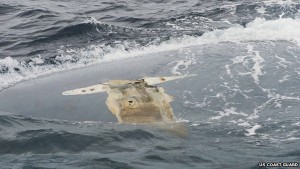
Seaworthiness has to do with the vessel’s ability to remain floating on the surface right-side up. In heavy weather the Murrelet centerboard and rudders can be retracted and, like a beach ball in surf , the vessel may bounce off breakers over a reef that can pound a long keeled sailboat out of existence in a short time. Owing to the cabin structure, Mac26x cruisers are similar to beach balls with ballast to keep them upright. The 1,400 pounds of water ballast and narrow hull of Mac26x cruisers provide the self-righting stability of a keel boats without the unfavorable features of a long keel. Center boarded light displacement hull sail boats should be more available for chartering.

Recent studies seem to contradict traditional arguments for the safety of long keels. One such study showed that these keels apparently drag when a boat slides sideways down a wave face, and trip the boat”
Modern Cruising Under Sail
Keels usually comprise the backbone of a vessel. A backbone is often the definition of a keel. Hence, touch and goes and heavy seas probably weaken the hull of fixed keel boats overtime making unreinforced older craft with 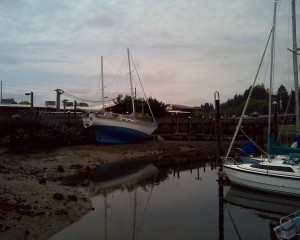 long keels ill suited for ocean crossing. Nonetheless, ocean crossing in a like new cruiser is viewed by Dobs as no more risky than freeway driving. Coastal ocean cruising is actually more risky than ocean crossing because the waves are larger and breaking near the coast and there are shallows.
long keels ill suited for ocean crossing. Nonetheless, ocean crossing in a like new cruiser is viewed by Dobs as no more risky than freeway driving. Coastal ocean cruising is actually more risky than ocean crossing because the waves are larger and breaking near the coast and there are shallows.
When a beach ball grounds it often does so in shallow water that will not support pounding breakers. I have become confident that I can batten down Murrelet’s hatches, hide below, retract the foils (centerboard and rudders) and ride any storm surge to calmer water or shallow water where I could drag anchor or beach as a beach ball would. Glass balls used for fishing nets do so. So do Zodiacs and other tenders.
Murrelet is a 5 ton by volume documentable vessel. She and all Mac26x boats delivered from the factory are foam filled so that they will act like a Zodiac in a storm, IE like a life raft. Hence, assuming I do not put several tons of lead pellets in her bilge, or bolt on a 2 ton keel, I do not need to be as concerned about being miles from shore. If needed the mast can be dropped on Mac26x cruisers thereby reducing weight aloft which is a contributor to capsizing. Even capsized Mac26x cruisers provide more shelter from exposure than life rafts. And of course the ability to motor above 10 MPH for 100 miles or more makes Murrelet nimble to avoid weather hazards. She should make passage as fast or faster than 60 plus foot sail boats. Fast passage is important in avoiding storms at sea. Once in harbor, Mac26x vessels can be lifted or trailered to dry storage or beached or at a minimum anchored close to a beach inside the storm breakers.
As the story of Onkabye and Gimcrack demonstrates, deep fixed keel sailboats are part of a long, important and interesting experimental period in yacht design. I respect their skilled sailors as I do those who sail square riggers. But for recreational boating, their continued use needs to be seriously questioned.
Vanishing Stability and Water Ballast
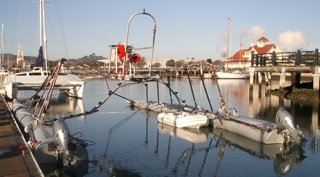 The PacCat is apparently very stable and its success explains odd contraptions like the one pictured to the left. This motor vessel consists of a frame attached to two inflated pontoons. I imagine it is used for some kind of fishing, perhaps sword fish off the coast of California. Two 25 hp motors are mounted. Note the ribbed dingy inside the starboard hull and blue water catamaran on her bow. All three craft have poor angles of vanishing stability.
The PacCat is apparently very stable and its success explains odd contraptions like the one pictured to the left. This motor vessel consists of a frame attached to two inflated pontoons. I imagine it is used for some kind of fishing, perhaps sword fish off the coast of California. Two 25 hp motors are mounted. Note the ribbed dingy inside the starboard hull and blue water catamaran on her bow. All three craft have poor angles of vanishing stability.
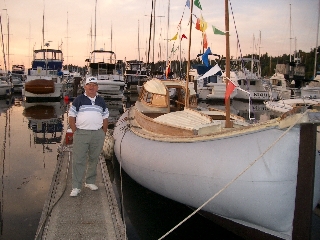 The capsize ratio or formula and ability of the craft to remain floating even if swamped are the most important items for survivability.Survivability and stability ratios are related to each other only for designs that by modern standards should be questioned.The wooden tall ships, because they could float, or parts of them could float, had survivability.
The capsize ratio or formula and ability of the craft to remain floating even if swamped are the most important items for survivability.Survivability and stability ratios are related to each other only for designs that by modern standards should be questioned.The wooden tall ships, because they could float, or parts of them could float, had survivability.
The angle of vanishing stability ratio has long been used to disparage multihulls from use as blue water cruisers. This ratio was used until recently to keep multihulls out of ocean races such as the West Marine TransPac. The angle to which the boat can heel and still right itself is the Angle of Vanishing Stability. Acording to US Sailing, the angle of vanishing stability is the resistance to capsize and heel and is one of the best predictors of ultimate stability.
A dingy will have a stability range of about 80 degrees, an inland water boat should have a stability range of 100 degrees, and an offshore sail boat of at least 120 degrees. Boats which have stability angles of less than 140 degrees may be left floating upside down once capsized. Boats with a higher angle will usually right themselves.
Roger MacGregor reports that for com parson purposes the stability ratio for the Mac26x is 115 and that when ballasted the vessel is completely self righting, indicating greater than 140. The load carried in the Mac26x impacts the calculation. http://www.sailingusa.info/cal__avs.htm is full in seeing that.
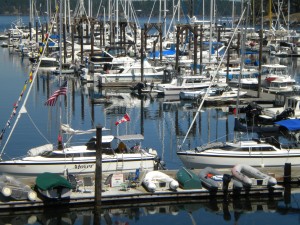 For example, unballasted with centerboard extended the Mac26x has an estimated angle of vanishing stablity of 112 by http://www.sailingusa.info/cal__avs.htm. Ballasted her estimated ratio is 130, best I can tell (the calulation shows minus 50. 180 – 50 = 130). I use 35 lbs as the weight of the centerboard in the estimates. When the Mac26m was introduced, it was believed that the weight of the water inside the centerboard should be included (about 100 lbs). I am cloudy on that. It is clear in anycase that when loaded down for an extended cruise, with gear and provisions properly secured, that the ratio for a Mac26x will be over 140. The calculation makes no distinction between ballast stored internally (in the form of secured gear, lead pellets or water) and weight tacked on to a keel in bulb or other form. A review of page 49 of a 1994 study shows our ballasted 26X boats to be one of the “good ones”.
For example, unballasted with centerboard extended the Mac26x has an estimated angle of vanishing stablity of 112 by http://www.sailingusa.info/cal__avs.htm. Ballasted her estimated ratio is 130, best I can tell (the calulation shows minus 50. 180 – 50 = 130). I use 35 lbs as the weight of the centerboard in the estimates. When the Mac26m was introduced, it was believed that the weight of the water inside the centerboard should be included (about 100 lbs). I am cloudy on that. It is clear in anycase that when loaded down for an extended cruise, with gear and provisions properly secured, that the ratio for a Mac26x will be over 140. The calculation makes no distinction between ballast stored internally (in the form of secured gear, lead pellets or water) and weight tacked on to a keel in bulb or other form. A review of page 49 of a 1994 study shows our ballasted 26X boats to be one of the “good ones”.
As with all useful ratios, this one makes one think about appropriate design. The Oden 820 and Potter notion of putting weight on a fin is a bad one for hull center line stress reasons if not just for drag reasons. When the X was designed this was known and it has become known in aircraft testing. Today craft such as the F/A-22 are redefining aircraft by moving missiles and fuel internally rather than beneath the wings. This gives them low aerodynamic drag allowing less fuel use. It has yet to be shown that bulb keels are desirable. In fact Ted Brewer and Bill Luders showed 40 years ago that they were not and Brewer still believes bulbs are foolish. See keel design. Stability is everything in boat design and if bulb keels were desirable designers would use them on power only vessels. They do not, preferring ballast in the form of golf cart batteries, engines, and in the case of fishing vessels, ice (a form of water ballast).



In a continuing effort to improve the customer experience, the Offshore Racing Association (ORA), the owner of the Offshore Racing Rule (ORR), will be offering the offshore community a new and improved Offshore Racing Rule, offering better customer support in the process. – See more at: http://www.sailingscuttlebutt.com/2014/11/05/upgrades-underway-offshore-racing-rule/#sthash.PHz8NQKQ.dpuf
Jim Teeters will be heading up this effort as part of the ORA initiative and will be partnering with ORA in continuing the development of ORR and its Velocity Prediction Program (VPP). Teeters, currently the Associate Director of US Sailing’s Offshore Office, will be leaving this position by mid-January 2015.
Teeters has seen many changes over the years in rating systems. “The last decade has witnessed profound changes in VPP accuracy as we incorporate the results of scientific experiments and the observation of actual racing,” states Teeters. “We have the benefit of an offshore team that is fully involved in the A to Z of the ORR: measurement, rating, fielding inquiries and trial certificates, close communication with event organizers, race observation, funded research and code development. The results of this can be seen in the wide variety of well-sailed, well-designed, boats that win ORR races. The move to a partnership with ORA will permit even greater focus on VPP development, at the same time expanding the core offshore team by closely integrating marketing and regatta support.”
– See more at: http://www.sailingscuttlebutt.com/2014/11/05/upgrades-underway-offshore-racing-rule/#sthash.PHz8NQKQ.dpuf
http://www.holidaylettings.co.uk/rentals/oporto/183364